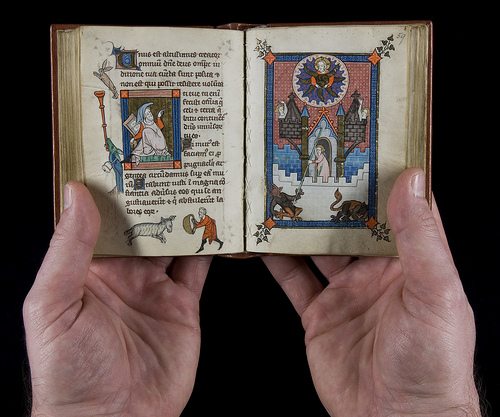
Rothschild Canticles (in Latin)
CC image courtesy of Beinecke Library on Flickr
Beinecke Rare Book and Manuscript Library, Yale University
As a part of librarian bootcamp, we had a field trip to visit Special Collections at SU, and to “oo” and “ah” over some amazing artifacts. One of my classmates asked if any of the objects had been digitized, and could be viewed on a website, and shared with others. Afterwards I found that for some of these objects, the answer is yes. But the host for our visit, Dr. Lavender, gave a quick and more general reply, about the difficulty of capturing the essence of these three dimensional objects in a digital format. Of course he’s right, but of course my classmates and I have good reasons for wanting to be able to “visit” these objects again, even if it’s just a digital visit. I have written about this in other places, including a couple of posts on this blog – I feel strongly that digital collections are an extremely important supplement to physical collections of historic objects. But, yes, careful scanning of such rare and fragile objects is difficult, dangerous, and expensive.
But what if we could just videotape Dr. Lavender’s presentation? I think that sharing videos of people interacting with objects is a great compromise. We can’t yet digitally capture the feeling of the weight of the book, or the texture you feel when you turn the pages, or the smell that wafts up when you open it. But we could capture his passion for these objects, his explanation of what each object expresses to him. We could get a sense of the weight and the texture by how he holds it, or how he verbally describes it. In such a video, we would benefit not only from exposure to the object, but also from exposure to the librarian’s expertise and emotion.
Yes, ideally we would also want a format in which the object could speak for itself, with as little mediation as possible, to allow for alternative perspectives from different people. But for many historic objects, especially ones that are rare and fragile, only a select few highly qualified people are ever allowed that kind of unmediated access. The rest of the time, it’s a part of a brief and supervised visit, or inside a glass case. What if we could use video, even just at its most cheap and efficient, as a way of capturing not just the object, but also the interaction with it, and the conversation it inspires?






One Response to capturing the conversation